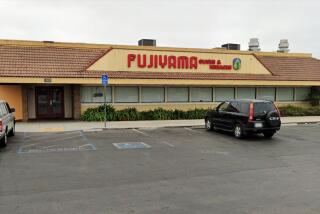Can Pour Service Get Worse?
Around the country, restaurants offering wine with their food seem to have a death wish. Most of them evidently think wine service is meaningless and they thus don’t train their personnel in how to serve wine.
And when you’re paying two to three times the retail price for a bottle of wine, good service should be part of the price.
Yet from the service I have seen, I get the impression that few restaurant people care about service. They also don’t seem to care that their poor service is likely to make wine lovers so disgusted that they won’t ever try to order wine in a restaurant again. Or dine there again.
I have more than a dozen stories of “bozo-ness” in wine service; a few will suffice. The following story is true, but only a fraction of the problems are listed here:
I was dining (I use the term loosely) recently at an inn in New Jersey, not a decision I made voluntarily, I might add. I noted on the wine list that one red wine by the glass was 1986 J. Lohr Cabernet Sauvignon, a fine wine that sells for about $7 a bottle. Despite the fact that at $4.50 a glass it was overpriced, I ordered it.
And what came to the table was clearly not Cabernet at all but a Beaujolais. I mentioned it to the waiter, who said, “You wanted the red wine, didn’t you?”
“Yes, but I wanted the Cabernet,” I replied, “and this is not Cabernet.” He took the glass away with a diffident shrug.
He returned with another glass (and I won’t tell you what the “glass” looked like). After taking a sniff and a sip, I determined that the wine inside was not J. Lohr Cabernet, but a much less expensive wine. I hailed the waiter and said, “This is not the wine on the wine list.”
He said, “It’s what the bartender poured.”
I said, “But I wanted the J. Lohr Cabernet. Could I see the bottle this came from?”
Back came the bottle. It was a Cabernet all right, but it was one that sells for about $3.50 a bottle and I have seen it for $2.79. I said, “Your list showed the ’86 J. Lohr. This is not J. Lohr.”
He said, “The bartender tells me we’re out of the J. Lohr, so he substituted this.”
“A wine that sells for less than half the price of the J. Lohr, huh? And I assume the price of this glass is not going to be $4.50 this evening?”
He took the question to be rhetorical and left. There was no manager around that evening to whom I could squawk, so I paid the bill and went to my room, fuming.
A similar problem happened to a colleague two years ago. Dining at a San Francisco-area restaurant (also in a hotel, coincidentally) he ordered a glass of Korbel Natural, a dry sparkling wine. When the wine came, it was sweet.
“Could I see the bottle?” he asked of the waiter.
“Is something the matter, sir?” said the waiter.
“I don’t think this is Korbel Natural,” he said.
The waiter left, to be replaced by “a guy in a black suit,” my friend said.
“Is something the matter, sir?” the man in the black suit asked. (This must be a phrase they teach you in restaurant school.)
My friend conveyed his concern; the manager said, “We are out of Korbel and we have substituted a very comparable wine.” He mentioned the name. It sells for $22 a case, wholesale.
A discussion ensued. My friend was a little upset (understatement) that a wine that could, and does, sell for $2.50 a bottle at retail would be substituted for a wine that sells for $12 a bottle with the patron not informed of this switch. Things got pretty nasty at that point. (My friend is known to be feisty, particularly when he’s right about something.)
Then there was the time a decade ago when we were sipping a bottle of Riesling. After the glasses at the table had been poured, four ounces remained in the bottle, which went back into the ice bucket.
Later our waitress returned, hoisted the bottle, glanced at it and, not seeing the wine remaining, turned the bottle upside down in the ice bucket, thereby pouring out what wine remained. (And what is this obsession that waiter staffs have with turning bottles upside down?)
Just a couple of weeks ago in a new downtown Los Angeles “chic-erie,” our water poured five glasses and began walking away with what was left, about three ounces. Only after we shouted across the restaurant did he return with our last one-ninth of the bottle.
And in a fashionable Beverly Hills boite, we ordered three bottles of wine, each of which was “out of stock,” and we were then offered a bottle that the restaurant had--but which was priced significantly higher than the ones I had been ordering.
Outside of price gouging, wine service in restaurants is one of the worst things we have to deal with. Ill-informed (or uninformed) servers make dining with wine a frustrating experience. And if my Cabernet episode and my compatriot’s Korbel incident are any indication, some of what’s going on is downright illegal.
Some time ago, I wrote a column about my pet peeves about wine. One comment about restaurant pricing generated loads of letters from people around the country who were irate (more than I, surprisingly) over what they considered sloppy, inconsiderate, uninformed service.
Some spoke of the outrage of paying $30 for a wine that retails for $12, and all high wine pricing in general, but the things that came through most clearly were complaints about the lack of proper service and the general malaise in the restaurant industry over a product that should truly enhance a meal while making the owner of the restaurant a tidy sum.
One letter was particularly vitriolic, evidence it was years in the making:
“Ah, a chance to vent some unspoken anger about restaurants and wait staffs when it comes to wine service,” she wrote. “Some ‘fine’ restaurants hire truck-stop quality people. They miss the whole idea of a ‘dining experience.’ Many a meal has been soured by poor wine service.
“Please do not fill my glass to the rim. Please do not keep coming back and sloshing more wine in my glass to keep it to the rim. Please tell me of the wine specials as well as the food specials. I have found an overlooked chalkboard special of something I would have ordered and the wait staff never let on there was something special. I feel like going back and taking a divot out of the tip.
“Consistently poor wait staff, poor wine lists, gouging wine prices, aargh. I keep a list of ‘Do Not Visit Here Again’ restaurants, which I share with friends generously.”
High restaurant pricing was the most-mentioned complaint of writers. One wrote, “These people have their nerve. They pay $8 for a wine that’s supposed to sell for $12 on the retail shelf, and they expect me to pay $24 or $28 for this? Hey, I can get it for $9.50 at my local discount shop, why am I going to pay $24 in a restaurant? So it can be served poorly by some clod who can’t even pronounce the wine?”
Another wrote, “Wine is the only product they (restaurants) sell that they can actually sell for more money the longer they have it. It’s not perishable like butter or cream. So why do they think we should pay a ridiculous sum for young wine that we can buy down at the local grocery store?”
Another complaint by two persons: the list that offers no vintage dates. I too detest seeing lists that say, “Chateau Haut-Brion, V.” The V is supposed to designate that they have the vintage-dated Haut-Brion. The fact that there is no such thing as a non-vintage Haut-Brion never crossed their mind.
But what vintage is it? Some years ago in a San Diego restaurant I saw this very listing on a wine list. The price was $48. So I asked what the vintage was.
The young man (a former surfer I’m certain) went away and returned to inform me he was sorry, they didn’t have anything younger. It was a 1971.
Needless to say, my friends and I dined at that place for months until the “old” wine was gone.
In this case, the restaurant deserved what it got. Had the vintage been on the wine list, a wine as fine as the ’71 Haut-Brion would never have sat there for a decade, unbought. And they could have gotten $100 or so for the bottle and still not overcharged.
Corkage policies also anger me. Often, I have a rare old wine I’d like to bring into the restaurant. So I call and inquire what the corkage policy is. Sometimes I’m told, “We don’t allow you to bring in your own wine.” So I dine elsewhere.
Or they say, “We’d be happy to let you bring your own wine in. The charge will be $12 per bottle.” I dine elsewhere.
At the enlightened places, corkage is a modest fee (perhaps $4 to $5 a bottle), and it’s frequently waived if you give the maitre d’ a sip of a rare old wine.
(One important point here, though: never bring into a restaurant a wine that’s already on the wine list, and avoid if at all possible young wines unless they are rare and hard to find. Restaurants have to stay in business.)
Wine of the Week: 1986 Graeser Winery Cabernet Sauvignon ($12)--Not particularly deep or dark, but this wine will age nicely, and it has such lovely fruit right now that you want to drink it. Except for a fairly tart finish, this is a most appealing wine, with cherry/herb components, a toastiness from oak and a lower level of tannins than you usually find in Cabernet. If this wine is tasted in a sterile setting, it’s hard to evaluate because of its tartness. But try it with food and watch it transform. Richard Graeser and wife, Celeste, run a poverty-stricken winery and young vineyard on the western slope of the mountains above Calistoga (not far from Diamond Creek). Graeser wines are not yet widely available but may be ordered by mail. Drop a note to Richard Graeser, 255 Petrified Forest Road, Calistoga, Calif. 94515.
More to Read
Eat your way across L.A.
Get our weekly Tasting Notes newsletter for reviews, news and more.
You may occasionally receive promotional content from the Los Angeles Times.










